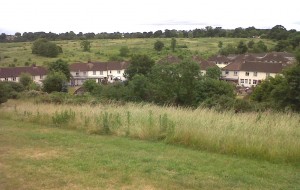Interesting comments from the London Wildlife Trust on the Mayor’s London Infrastructure Plan. It would be good if it does mean more protection for green spaces, yet at the moment Bexley Council is planning to build on a large Site of Importance for nature Conservation – Erith Quarry.

The Erith Quarry site seen from Hollyhill Open Space in June 2014. There used to be considerably more valuable scrub until former owners DHL Ltd bulldozed the site, despite it being at the highest grade of Borough level importance for wildlife. (Photo: Chris Rose).
******************************************************************************
London Wildlife Trust welcomes the Mayor’s publication of the London Infrastructure Plan 2050 and the commitment within to ensure that green infrastructure – the network of the city’s parks, nature reserves, rivers, woodlands and other green spaces – are part of the plan.
The plan’s recognition of the role of the capital’s natural environment is critical for ensuring that wildlife and nature have a place in the London of the future, and acknowledges that green spaces are essential to the city’s social andeconomic well-being.
We support the plan’s aspirational commitments to create 9,000 hectares of new accessible green space, and provide 10% more green cover in central London.
The Trust welcomes the decision to establish a Green Infrastructure Task Force. Having long-standing experience of conserving London’s natural environment, we aim to contribute to the work of the Task Force.
Nevertheless the Trust is concerned that the plan remains unclear as to the protection that will be given to the existing 1,500 plus sites of wildlife importance in London, nor how it will meet the commitments to restore and create important habitats to reverse the decline in the capital’s biodiversity, as set out in The London Plan in 2011.
More homes and more green space, but where will the space come from?
It also claims that the aspirational targets to build 1.5 million homes and other infrastructure will not encroach upon the Green Belt, which we consider an unlikely ambition given the existing pressures to expand. We also note that there are many other valuable green spaces in London that are vulnerable to being lost to development.
The plan also fails to make clear whether the ambitious targets for new, accessible space will lead to a net gain in the quantity of green space. Will the new spaces simply replace other spaces that will be lost, or will existing, closed spaces be made accessible? The greening of street and roofs will be of benefit, but they are not replacements for the loss of complex wildlife habitats.
Critically the Infrastructure Plan needs to result in a significant net gain for wildlife, if it is to make a London a pleasant place to live, work and play. We will work with others to ensure that this can happen.
London Wildlife Trust urges people to respond to the Infrastructure Plan, and to ensure that nature’s place in the future city is sufficiently protected, respected and enhanced.
You can respond to the London Infrastructure Plan here:
https://www.london.gov.uk/priorities/business-economy/vision-and-strategy/infrastructure-plan-2050
The consultation closes on 31st October 2014.
